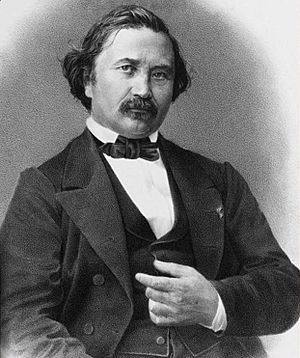Joseph Bertrand facts for kids
Quick facts for kids
Joseph Louis François Bertrand
|
|
|---|---|
 |
|
| Born | 11 March 1822 |
| Died | 5 April 1900 (aged 78) Paris, France
|
| Scientific career | |
| Fields | Mathematics |
Joseph Louis François Bertrand (born March 11, 1822 – died April 5, 1900) was a famous French mathematician. He studied many different areas of math, including number theory (about numbers), differential geometry (about shapes and spaces), probability theory (about chances), economics (about money and trade), and thermodynamics (about heat and energy).
Contents
Early Life and Education
Joseph Bertrand was born in Paris, France. His father was a doctor named Alexandre Jacques François Bertrand. Joseph also had a brother, Alexandre, who became an archaeologist.
Sadly, Joseph's father passed away when Joseph was only nine years old. Even at this young age, Joseph was very smart. He could understand difficult math ideas like algebra and geometry. He was also able to speak Latin very well.
When he was eleven, Joseph attended classes at a famous school called the École Polytechnique. He was so bright that he earned two bachelor's degrees, a license, and a PhD by the time he was seventeen. His PhD paper was about the math of electricity.
A Career in Mathematics
Joseph Bertrand became a professor at the École Polytechnique and the Collège de France. These are very important schools in France. He was also a member of the Paris Academy of Sciences. He worked there as a permanent secretary for twenty-six years. This means he helped manage the academy for a long time.
Important Discoveries and Ideas
Bertrand made many important contributions to mathematics.
Bertrand's Postulate
In 1845, he suggested an idea about prime numbers. He thought that there is always at least one prime number between any number n and twice that number minus two (2n − 2), as long as n is greater than 3. For example, if n is 4, then 2n − 2 is 6. There is a prime number (5) between 4 and 6.
A mathematician named Chebyshev later proved this idea in 1850. It is now known as Bertrand's postulate.
Bertrand's Paradox
Joseph Bertrand is also famous for a puzzle in probability theory. This puzzle is called Bertrand's Paradox. It shows how tricky probability can be. There is also another puzzle in game theory named after him, called the Bertrand Paradox.
Real Numbers
In 1849, Bertrand was the first to explain what are now called real numbers using a method called a Dedekind cut. This was an important step in understanding numbers more deeply.
Translating Important Works
Bertrand also helped share important math ideas by translating books. He translated the work of Carl Friedrich Gauss into French. Gauss's work was about the theory of errors and the method of least squares. These are ways to find the best fit for data.
Ideas in Economics
Bertrand also looked at ideas in economics. He studied how companies compete with each other. He reviewed a model by another French mathematician, Antoine Augustin Cournot, about how companies set their prices.
Bertrand thought Cournot's idea was misleading. He created his own model, called the Bertrand Competition Model (1883). In his model, companies compete by changing their prices, not how much they produce. He showed that when companies compete this way, the final price can be very close to the lowest possible price.
Understanding Thermodynamics
In his book Thermodynamique, Bertrand wrote about thermodynamics. This is the study of heat and energy. He was one of the first people to point out that concepts like thermodynamic entropy and temperature are only clearly defined for processes that can be reversed.
Recognition
In 1858, Joseph Bertrand was chosen as a foreign member of the Royal Swedish Academy of Sciences. This was a great honor for his work.
Works by Bertrand
- Traité de calcul différentiel et de calcul intégral (Paris : Gauthier-Villars, 1864–1870) (a two-volume book on calculus)
- Rapport sur les progrès les plus récents de l'analyse mathématique (Paris: Imprimerie Impériale, 1867) (a report on new progress in mathematical analysis)
- Traité d'arithmétique (L. Hachette, 1849) (a book on arithmetic)
- Thermodynamique (Paris : Gauthier-Villars, 1887) (a book on thermodynamics)
- Méthode des moindres carrés (Mallet-Bachelier, 1855) (his translation of Gauss's work on least squares)
- Leçons sur la théorie mathématique de l'électricité / professées au Collège de France (Paris : Gauthier-Villars et fils, 1890) (lessons on the mathematical theory of electricity)
- Calcul des probabilités (Paris : Gauthier-Villars et fils, 1889) (a book on probability)
- Arago et sa vie scientifique (Paris : J. Hetzel, 1865) (a biography of Arago)
- Blaise Pascal (Paris : C. Lévy, 1891) (a biography of Blaise Pascal)
- Les fondateurs de l'astronomie moderne: Copernic, Tycho Brahé, Képler, Galilée, Newton (Paris: J. Hetzel, 1865) (biographies of founders of modern astronomy)
See also
 In Spanish: Joseph Louis François Bertrand para niños
In Spanish: Joseph Louis François Bertrand para niños
- Bertrand paradox (probability)
- Bertrand paradox (economics)
- Bertrand's box paradox
- Bertrand's postulate
- Bertrand's theorem
- Bertrand's ballot theorem
- Bertrand–Edgeworth model
- Bertrand curve
- Buckingham π theorem

